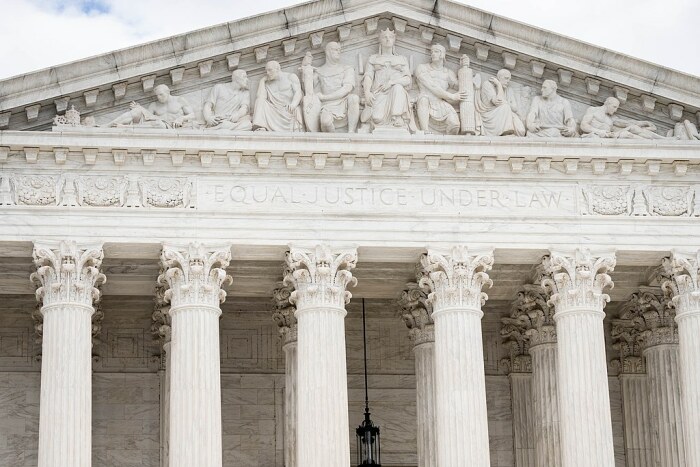Rick Morain is the former publisher and owner of the Jefferson Herald, for which he writes a regular column.
“Power tends to corrupt, and absolute power corrupts absolutely.”—Lord Acton, 1887
We usually hear this statement when someone wants to make a point about someone else, someone in power. I’m doing just that. And those to whom I want to point in this case are the justices of the U.S. Supreme Court.
It’s not hard to name institutions about which Lord Acton’s statement rings true.
Sea captains, especially in olden days, sometimes abused their ultimate power over their sailors. Some religious leaders take advantage of their flocks and perpetrate crimes upon believers. Chiefs of young people’s organizations, like Boy Scouts, on occasion work their criminal will on their youthful members.
Whenever someone holds great power over the activities and careers of his or her followers—college professors, psychiatrists, employers, and military superiors come to mind—history teaches us that the temptation to abuse that power occasionally becomes too strong to resist. The temptation is strongest when the victim feels he or she has little or no recourse for justice.
Thankfully, such perpetrators amount to a small minority. Most leaders reached their positions because they evinced ethical behavior as well as good judgment, and they continue to do so after their rise to leadership.
But when no guardrails are in place, conditions for corruption in all its forms exist. The behavior of individual U.S. Supreme Court justices sometimes has fallen into that category.
The Judicial Conference of the United States adopted the Code of Conduct for United States Judges in 1973. The code applies to U.S. circuit judges, federal district judges, Court of International Trade judges, Court of Federal Claims judges, bankruptcy judges, and magistrate judges.
Notice something missing?
That’s right: U.S. Supreme Court Justices, the most powerful judges in the land, are not required to follow the Code of Conduct. Nor is there any other required code for them. Their only strictures are self-imposed and voluntary.
The Code of Conduct for all but Supreme Court judges includes five basic canons.
- A judge should uphold the integrity and independence of the judiciary.
- A judge should avoid impropriety and the appearance of impropriety of all activities.
- A judge should perform the duties of the office fairly, impartially and diligently.
- A judge may engage in extrajudicial activities that are consistent with the obligations of judicial office.
- A judge should refrain from political activity.
If Supreme Court justices were subject to the Code of Conduct, some recent revelations involving Justices Clarence Thomas and Neil Gorsuch could well come under official investigation. Both men, as Supreme Court Justices, have engaged in questionable financial dealings with highly influential Americans.
Thomas accepted valuable gifts and luxury travel for years from a GOP megadonor, Harlan Crow. Crow bought a Savannah, Georgia home from Thomas, where the justice’s mother lives rent-free. Crow also covered expensive private school tuition for the relative Thomas was raising as a son.
The justice disclosed none of those transactions as federal law requires.
Gorsuch sold real estate to the head of a law firm with business before the court in 2017, just days after Gorsuch was sworn into a lifetime seat on the Supreme Court, according to a recent investigation.
But even if a binding code of conduct were in place, lawsuits against Supreme Court justices could eventually work their way through the federal appeals courts and go on up to…the Supreme Court, which since 1958 has claimed to be our ultimate arbiter of justice.
When the Founders drafted the U.S. Constitution in 1787, they included Article III, which governs U.S. courts. Its only specific ethical requirement is in Section One of that article: “The Judges, both of the supreme and inferior Courts, shall hold their offices during good Behaviour, . . .” Discipline of misbehaving judges is left to Congress through its impeachment power.
Only fifteen judges throughout the entire federal system have ever been impeached by the U.S. House. The U.S. Senate has convicted and removed just eight of them.
The only Supreme Court Justice ever to be impeached was Samuel Chase in 1804. Chase had been appointed by Federalist President George Washington in 1796. Jeffersonian Republicans in the U.S. House in 1804 accused him of acting in a partisan manner during several trials. The Senate acquitted him in 1805, and he continued to serve until his death in 1811.
Whether Congress can regulate conduct of Supreme Court Justices in a manner other than the drastic step of impeachment remains cloudy. But the Senate Judiciary Committee has taken the first step to do just that. The committee, under Democratic leadership, held a hearing on May 2 in hopes of getting the Supreme Court to write a code of conduct for itself. Otherwise, Congress may write one.
Democrats on the committee raised questions of financial impropriety by the Justices, as well as some of their questionable political-related appearances with conservative organizations. Republicans countered with the accusation that Democrats are just playing politics with a goal of delegitimizing the court.
With the Senate requiring 60 votes to take action and with the House in Republican hands, regulatory action by Congress is highly unlikely. But maybe the bad press will encourage the Supremes to enact a formal code of conduct for themselves at last.
Public opinion polls show the high court’s approval rate is the lowest ever recorded. An official code of conduct could help slow the bleeding.
Top image: U.S. Supreme Court building, photographed by Anthony Quintano on March 20, 2022, available via Wikimedia Commons.

